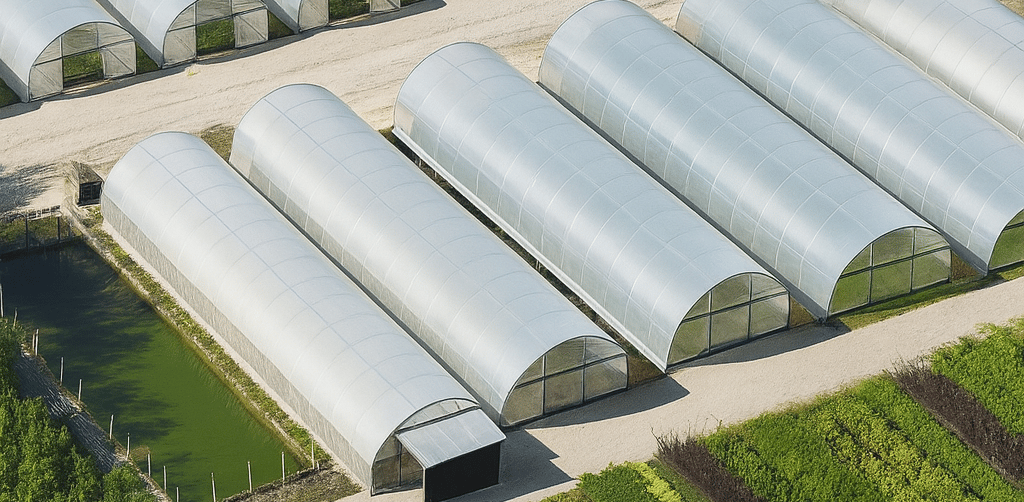

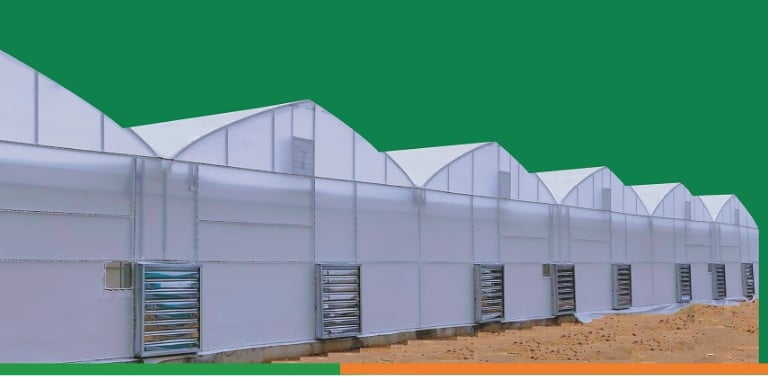

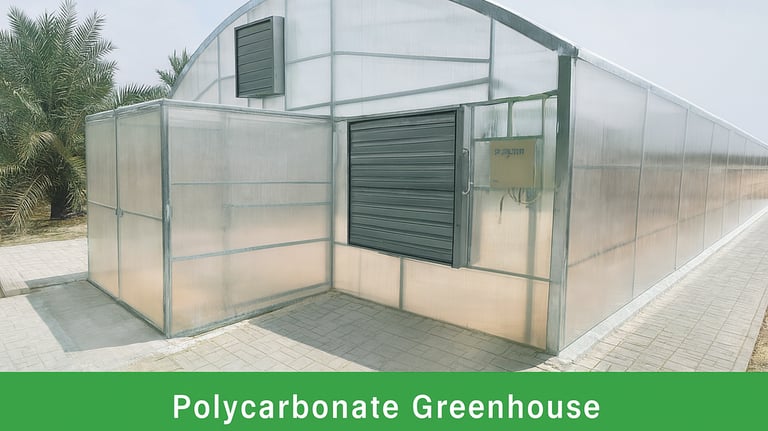



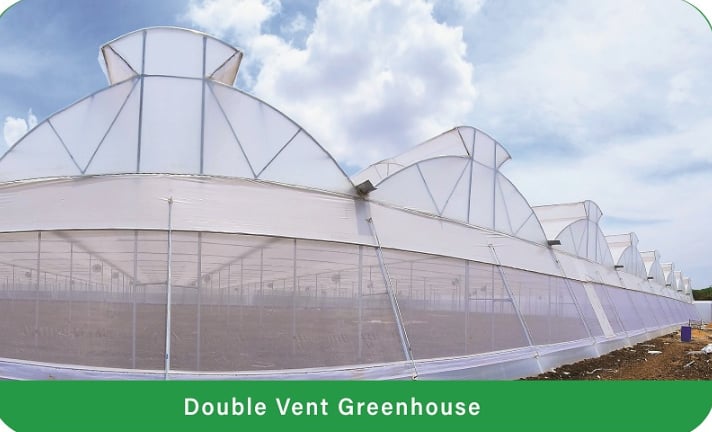

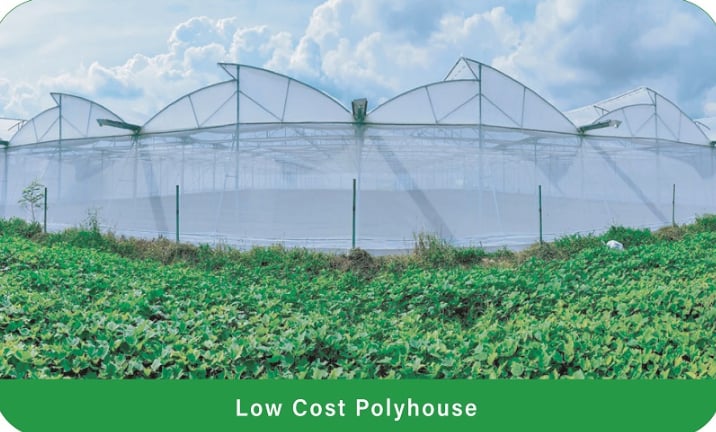

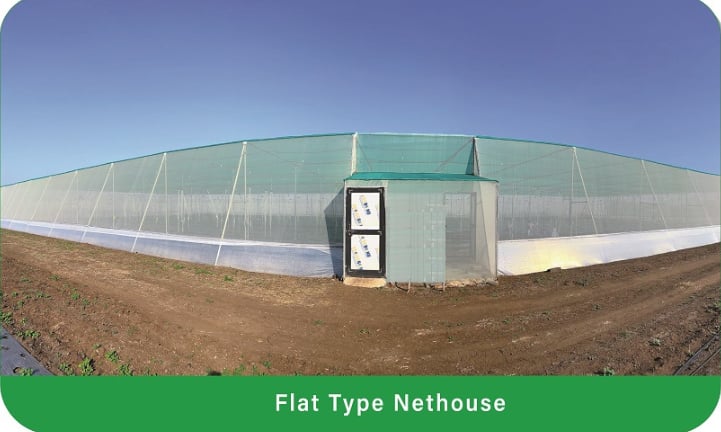

RNAGRI AGRO SOLUTIONS PVT.LTD.
Built For Growth
PREMIUM GREENHOUSE STRUCTURES
MOB- 91+952009966 , 91+7902171734
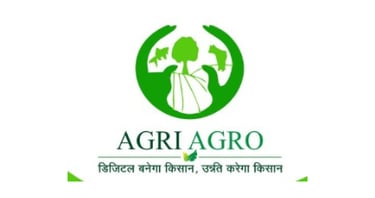

rnagriagro@gmail.com
ABOUT US
RNAGRI AGRO was established in Agra, India, and it is one of the leading manufacturers and service providers of Hi-Tech protected farming solutions and different kinds of greenhouse structures.
We have undertaken and successfully executed many projects over the years in almost all Indian states: Rajasthan, Madhya Pradesh, Maharashtra, Punjab, Karnataka, Haryana, Uttarakhand, Uttar Pradesh, Himachal Pradesh, Jammu & Kashmir, Delhi, among others.
We are also increasing our presence internationally. RNAGRI AGRO has executed greenhouse projects in African nations, Arabian countries, and Nepal. We are proud to be one of the emerging international-level greenhouse manufacturers in India.
Having worked extensively within the industry, we have established ourselves as leaders in the market concerning greenhouse development and decorative flower and exotic vegetable cultivation. Keeping in mind the growing demand for sustainable farming globally, innovation and cost-effective greenhouse solutions have remained our focus.
Since 2011, we are deeply involved in completely automated farming, soilless farming, and AI-based farming systems. Further, we take up organic and self-integrated greenhouse projects, nursery production, contract farming, and buy-back arrangements to assist our clients in selling their produce in domestic and international markets. Our clients grow a wide range of exotic vegetables, flowers, and other high-value crops.
RNAGRI AGRO is committed to offering premium quality products, timely services, reliable after-sales support, and expert agronomy guidance.
🌿 What Is a Greenhouse?
A greenhouse is a specially designed structure that creates a controlled environment to help plants grow better. It shields plants from harsh weather conditions and protects them from pests, insects, and animals.
Greenhouses come in a variety of shapes and sizes — from small backyard setups to large commercial farms. Some of the most common types include Fan & Pad Greenhouses, Naturally Ventilated Greenhouses, and Polycarbonate Greenhouses. Depending on the need, they can be heated or cooled using water, electricity, or both, ensuring the right conditions for plant growth all year round.
🌸 Benefits of a Greenhouse
Grow high-value flowers and vegetables throughout the year.
Maintain the ideal conditions for healthy and steady plant growth.
Control temperature, humidity, lighting, and CO₂ levels efficiently.
Increase production capacity and yield, even in limited space.
Protect crops from damaging weather such as wind, rain, hail, and frost.
Support vertical farming, allowing you to grow more in less space.
🏠 Shapes of Greenhouses
Tunnel
Dome
Saw Tooth
Tailor-Made Structures

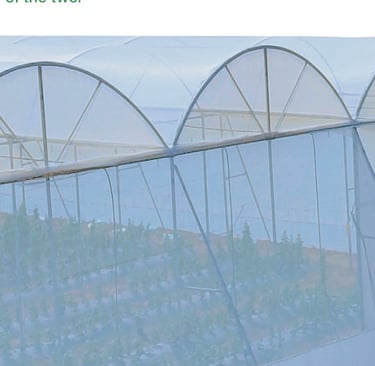
🌿 Types of Greenhouses
1. Fan & Pad Greenhouse
The Fan & Pad Greenhouse uses a highly efficient mechanical cooling system that ensures a stable and optimal environment for plant growth. This system can lower the internal temperature by 5°C to 15°C, providing excellent protection against heat stress and maintaining ideal humidity levels — even during the hottest summer days or cooler winter months.
This advanced setup not only enhances crop health but also boosts productivity by creating consistent growing conditions throughout the year.
Specifications & Applications:
Ideal for a wide range of uses, including:
Hydroponics
Aquaponics
Agriculture
Strawberry Cultivation
Tissue Culture
Hardening Chambers
🌿 2. Polycarbonate Greenhouse
The Polycarbonate Greenhouse is a premium, long-lasting, and versatile structure designed to perform exceptionally well in all types of climates. Built with high-strength polycarbonate sheets, it can easily withstand heavy winds, snowfall, and even sandstorms, ensuring reliable protection for your crops year after year.
One of its biggest advantages is its ability to diffuse harmful UV rays while allowing optimal sunlight penetration. This creates a balanced light environment that encourages faster and healthier plant growth in both hot and cold regions.
Specifications & Applications:
Perfect for:
Exotic Vegetables and Fruits
Research Centers
Experimental Seed Production Units
🌿 3. Naturally Ventilated Greenhouse
The Naturally Ventilated Greenhouse is a smart and energy-efficient structure designed to maintain ideal growing conditions using natural airflow. Instead of relying heavily on mechanical systems, it uses natural ventilation to control temperature, shade, and humidity inside the greenhouse.
The design features ventilation openings at the center of each span, allowing fresh air to circulate freely across a wide area. As warm air naturally rises, it escapes through the top vents — effectively reducing both heat and humidity levels. This creates an ideal environment for growing flowers and crops that prefer low humidity.
Thanks to its simplicity, cost-effectiveness, and eco-friendly design, naturally ventilated greenhouses are widely used around the world for a variety of crops.
Specifications & Applications:
Perfect for cultivating:
All types of Vegetables
Flowers
Medicinal and Herbal Plants
🌿 4. Double Vent Greenhouse
The Double Vent Greenhouse is a smart and durable solution designed for regions with unique climate conditions and specific crop requirements. Its advanced structure ensures optimal airflow and ventilation, making it ideal for maintaining consistent growing environments throughout the year.
The greenhouse is covered with a high-quality polyethylene film, securely attached using reusable PVC or aluminum locking profiles. Built to handle standard wind and vertical loads, it offers long-lasting stability and strength. Depending on your needs, the sidewalls can be fitted with polyethylene covers, polycarbonate sheets, or automated/manual curtains, ensuring flexibility and adaptability for various crops.
Specifications & Applications:
Perfect for cultivating:
Exotic Vegetables and Fruits
Research & Experimental Seed Centers
🌿 5. Low-Cost Poly house
The Low-Cost Poly house is an affordable and efficient solution for farmers looking to achieve high-quality crop production with minimal investment. Designed primarily for cultivating Capsicum, Tomatoes, Cucumbers, Coriander, and a variety of vegetables, this structure ensures consistent growth conditions and superior yield.
Low-cost poly houses are also widely used in nurseries for growing ornamental plants, thanks to their simplicity and cost-effectiveness. The polyethylene film covering helps maintain an optimal ambient temperature inside the structure, creating a favorable environment for healthy plant growth throughout the year.
This model is one of the best and most economical options under the category of Naturally Ventilated Greenhouses, offering excellent value without compromising on performance.
Specifications & Applications:
Perfect for cultivating:
All types of Vegetables
Flowers
Medicinal and Herbal Plants
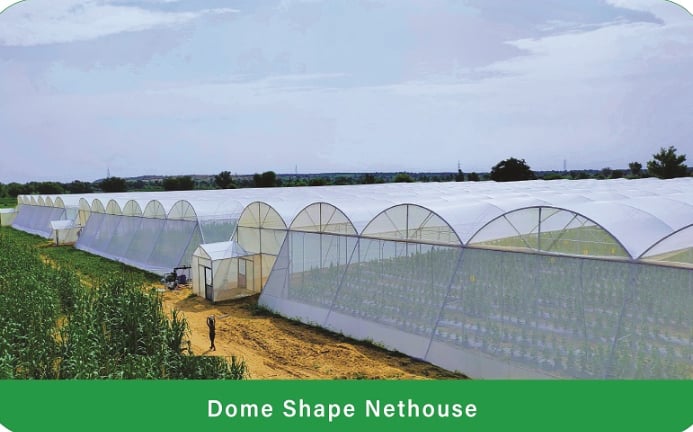

🌿 6. Dome Shape Net House
The Dome Shape Net House is a modern and cost-effective structure designed to provide the perfect growing environment for a wide range of crops. Its dome-shaped design ensures excellent cross ventilation, allowing fresh air circulation and maintaining ideal temperature and humidity levels for plant growth.
These structures are ideal for cultivating vegetables like Tomatoes, Capsicum, and Cucumbers, as well as flowers and ornamental plants. The shade nets used in these houses are available in different shading percentages, enabling growers to select the most suitable option based on crop type and local climatic conditions.
In addition to optimizing growth, Dome Shape Net Houses offer effective protection against hail, harsh sunlight, and insect attacks, ensuring healthier and higher-yielding crops year-round.
Specifications & Applications:
Perfect for cultivating:
All types of Vegetables
Nursery and Ornamental Crops
🌿 7. Flat Type Net House
The Flat Type Net House is a lightweight and economical structure designed to protect crops while ensuring excellent air circulation. Built using strong poles and tensioned cables that support the shade net, this design provides a stable and efficient growing environment for various crops.
In this model, air vents and side walls are covered with high-quality shade net material, which helps safeguard plants from insects, pests, and harsh weather conditions such as wind or excessive sunlight. In some designs, the entire wall structure is made of net-shade fabric, offering maximum ventilation and consistent temperature control.
Compared to the dome-type net house, the flat design offers a more economical solution while maintaining durability and functionality — making it a great choice for farmers and nursery owners seeking affordable protection for their crops.
Specifications & Applications:
Perfect for cultivating:
Vegetables and Ornamental Plants
Nursery Crops
Herbal and Medicinal Plants
🌿 8. Wire Rope Net house
The Wire Rope Net house is a cost-effective and durable solution designed to help farmers extend their growing season and even enable off-season cultivation. This structure provides a controlled environment that allows you to manage key growth factors such as light, temperature, humidity, CO₂ levels, and the root zone environment, ensuring consistent and healthy crop development.
Built with a strong wire-supported framework, this nethouse offers long-lasting stability while remaining highly economical — making it an ideal choice for commercial and nursery growers. It effectively protects crops from harsh sunlight, pests, and unpredictable weather conditions, allowing for better yields throughout the year.
Overall, the Wire Rope Net house is a reliable, low-cost structure that combines strength, simplicity, and efficiency for modern agricultural needs.
Specifications & Applications:
Perfect for:
Nursery Growers
Vegetable Cultivation


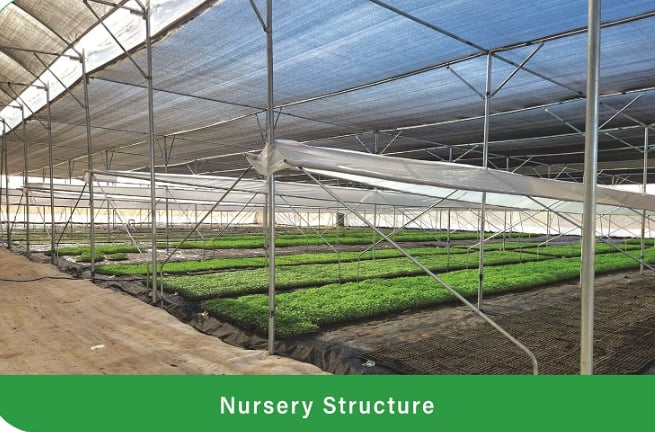

🌿 9. Nursery Structure
The Nursery Structure is specially designed to create an ideal environment for seedling preparation, plant hardening, and nursery operations. Built with precision and durability in mind, these structures provide the perfect balance of light, ventilation, and protection to ensure healthy and vigorous plant growth.
We design and manufacture single-layer, double-layer, and triple-layer nursery systems, tailored to meet the diverse needs of modern horticulture and commercial nurseries. Each design is crafted using high-quality materials to ensure long-lasting performance and minimal maintenance.
Whether you’re nurturing delicate seedlings or managing large-scale nursery operations, our Nursery Structures deliver consistent results and optimum growing conditions throughout the year.
Specifications & Applications:
Perfect for:
Nursery Plants
Seedling Production
Gardening and Ornamental Plants


Walk-In Tunnel House
A Walk-In Tunnel covers the cultivation area with a curved structure that is spacious enough to walk and work inside comfortably.
These tunnels are versatile and commonly used for vegetable farming, floriculture, and by small growers or hobby cultivators.
Their simple design makes them economical, easy to install, and highly effective for crop protection.
Specifications
Application: Vegetables, floriculture, small growers & hobby houses.
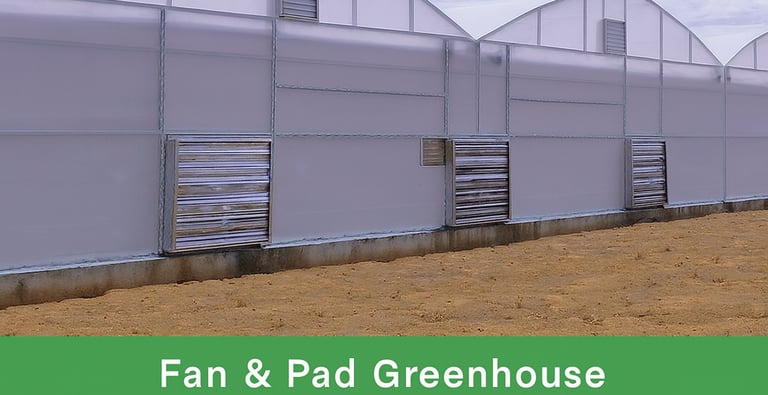



WE ARE SINGLE WINDOW SOLUTION


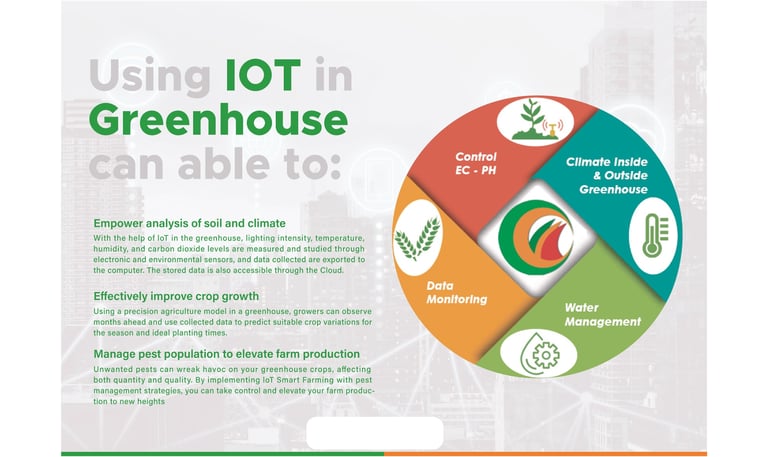



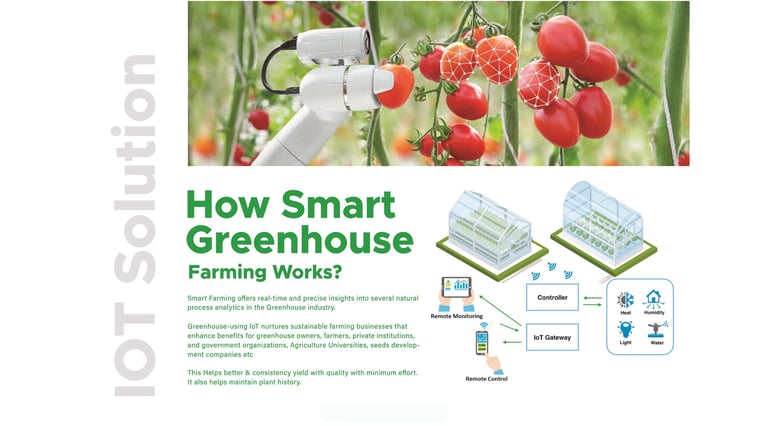

How Smart Greenhouse Farming Works?
Smart Farming provides real-time and accurate insights into various natural processes inside the greenhouse.
With IoT technology, greenhouse farming becomes more efficient, productive, and easy to manage.
IoT-enabled greenhouses offer sustainable solutions for farmers, greenhouse owners, private institutions, government organizations, agricultural universities, and seed development companies.
This technology helps achieve better and consistent yields with higher quality while reducing manual effort.
It also assists in maintaining complete plant growth history and environmental records.
Using IoT in Greenhouse Can Enable:
Empower Analysis of Soil and Climate
With the help of IoT in the greenhouse, lighting intensity, temperature, humidity, and carbon dioxide levels are measured and monitored through
electronic and environmental sensors. The collected data is exported to the computer and is also accessible through the Cloud.
Effectively Improve Crop Growth
By using a precision agriculture model in the greenhouse, growers can predict crop variations months in advance. IoT helps analyze collected data
to determine the best planting season and ideal growing conditions.
Manage Pest Population to Elevate Farm Production
Unwanted pests can severely affect greenhouse crops, impacting both quantity and quality. With IoT-based smart pest management strategies, farmers can take control and significantly enhance farm productivity.
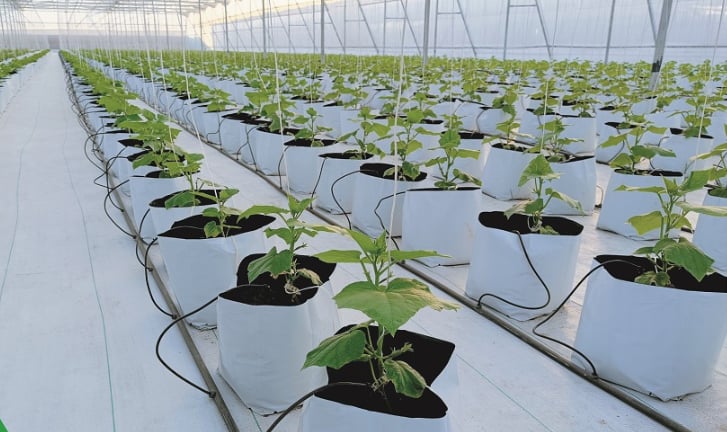

Soilless & Cocopeat
Cocopeat is a renewable and sustainable material made from coconut husk. It offers several advantages over traditional soil and is widely used for creating coco grow bag turnkey projects.
The cocopeat grow bag project is an ideal solution for greenhouses where soil is not available or for growers who want the benefits of cocopeat without investing in a full-scale soil-based setup. Made from 100% cocopeat, these grow bags can efficiently store water, air, and essential nutrients for plants.
Cocopeat Culture Project Types:
Trough Beds
Grow Slabs
Grow Bags
Benefits
🍃 Eco-friendly and sustainable material
Easy to install on any type of non-fertile land.
🍃 High water absorption & retention
Cocopeat can be easily wetted and re-wetted, with a water holding capacity of up to 77%.
🍃 No heavy preparation required
Does not require digging, soil preparation, or heavy groundwork.


SELECT THE APPROPRIATE COCOPEAT
SOLUTIONS FOR YOUR GREEN HUOSE
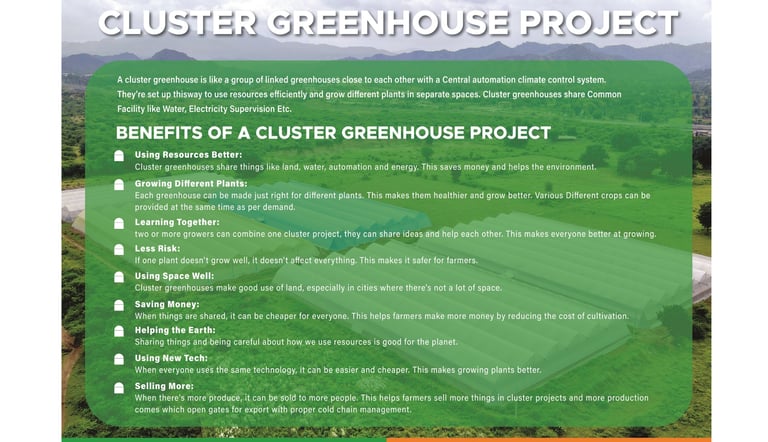

CLUSTER GREENHOUSE PROJECT
A cluster greenhouse is a group of connected greenhouses located close to each other and managed through a central automation climate-control system.
This setup helps utilize resources efficiently and grow multiple crops in separate controlled spaces.
Cluster greenhouses also share common facilities like water supply, electricity, and supervision systems.
BENEFITS OF A CLUSTER GREENHOUSE PROJECT
🔒 Using Resources Better
Cluster greenhouses share land, water, automation, and energy — reducing costs and helping the environment.
🔒 Growing Different Plants
Each greenhouse can be customized for different crops, improving plant health and ensuring better growth. Multiple crop varieties can be produced simultaneously as per market demand.
🔒 Learning Together
When two or more growers work under one cluster project, they share ideas, knowledge, and support — improving overall productivity.
🔒 Less Risk
If one crop fails or underperforms, the whole system is not affected. This minimizes risk for farmers.
🔒 Using Space Efficiently
Cluster greenhouses maximize the use of land, especially in areas with limited available space.
🔒 Saving Money
Shared resources lower operational costs, helping farmers earn more profit.
🔒 Helping the Environment
Shared usage of inputs reduces wastage and supports sustainable farming practices.
🔒 Using New Technology
Common advanced technologies make operations easier, faster, and more economical,
improving crop quality.
🔒 Selling More
Higher production leads to better market opportunities. Cluster farming supports bulk supply, export potential, and efficient cold-chain management.
Hydroponics
Hydroponics is a type of agriculture that does not require soil. It allows plants to grow in an efficient, clean, and sustainable way.
In hydroponic systems, water is used as the nutrient carrier for plants, which means that any plant can be grown throughout the year.
Since the nutrient water is recycled in a closed-loop system, hydroponics uses significantly less water compared to traditional farming.
Benefits
🔒 Requires less space than traditional farming.
🔒 Plants can grow using up to 98% less water compared to conventional methods.
🔒 Less labor is needed, making operations easier and more efficient.
🔒 Production increases 3 to 10 times in the same amount of space.
🔒 Plants receive the ideal amount of nutrients directly at the roots.
🔒 You can fully control the micro-climate in a hydroponic system.
Hydroponic Types
Flat Bed
In a Flat Bed Hydroponics system, plants are arranged on horizontal layers. A tube-like channel holds the plants in small net pots, with roots suspended at the bottom. Nutrient solution flows through the tube, giving roots access to both water and oxygen.
DWC (Deep Water Culture)
In this method, plant roots remain submerged in nutrient-rich water. The nutrient solution flows directly through the tub, allowing roots to receive both nutrients and exposure to oxygen.
A-Frame System
This system is designed in the shape of the letter “A”. Water flows from the top level to the layers beneath it. A-Frame systems are preferred for their excellent aeration and optimal space utilization.
Dutch Bucket
The Dutch Bucket system uses buckets filled with media such as coco peat, clay balls, etc., which support roots and ensure good aeration. Nutrient solution is mixed with water and supplied to each bucket through drippers.
Indoor Setup
Indoor hydroponics involves growing plants under artificial light sources such as LED. This method supports the growth of herbs, tomatoes, peppers, leafy vegetables, and various fruits throughout the year.

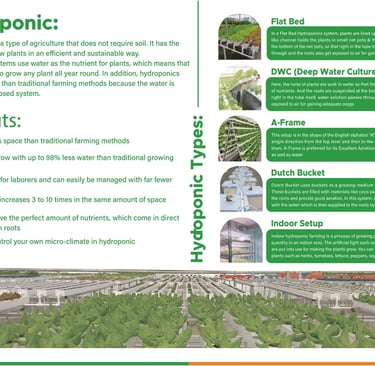
Automation System
System Overview
This is a climate and irrigation control, computer-based system designed for greenhouse growers of flowers and vegetable crops.
The system controls the heating and cooling of water and air in different zones.
You can control temperature, humidity, and CO₂ levels accurately during both day and night.
Key Features
Provides maximum accuracy in fertigation, water feeding, and complete climate control for growing flowers and vegetables.
The system can program and control more than one poly house at the same location simultaneously.
Equipped with sensors for automatic monitoring of temperature, humidity, and CO₂ levels.
A cloud-based platform allows you to operate and monitor the system from anywhere, anytime.
Continuous monitoring and reporting of climate levels during day and night.
Benefits
Creates and maintains an ideal environment based on programmed data.
Allows you to fully control your greenhouse climate through a computer.
Ensures plants receive the right amount of water and prevents over-watering and flooding inside the greenhouse.
Systems are programmed for automatic fertigation and irrigation with accurate EC and pH control.
Automation can be fully customized as per your specific requirements and budget.
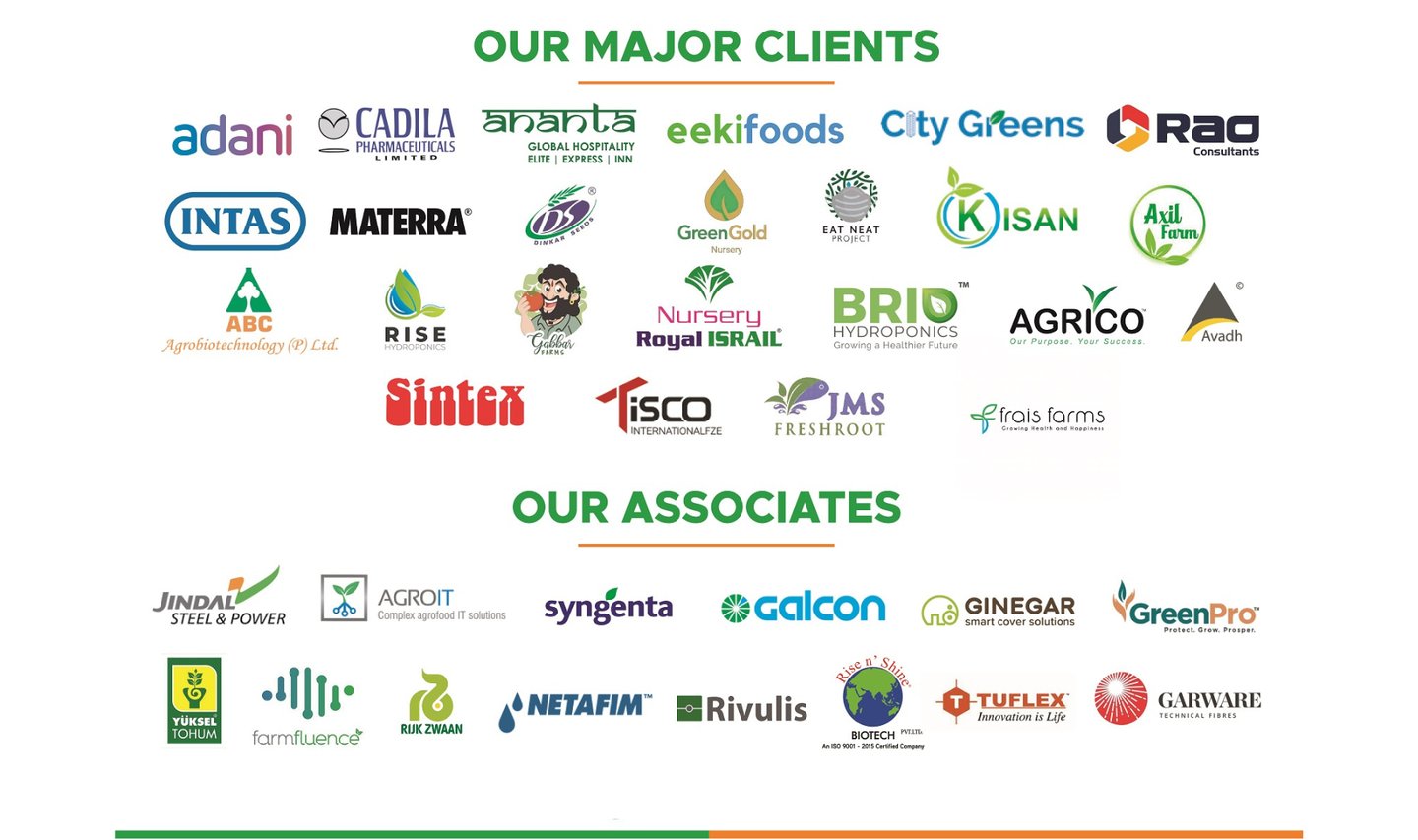

OUR MAJOR CLIENTS
Our Presences in India & Global
Our Presences in India & Global


About Agri Agro Grand Expo
Agri Agro Grand Expo International has served as a platform for bringing together many foreign as well as national visitors from all over the country to interact with leading national agriculture technology companies. The Agriculture Expo, held annually, is one of the leading national agriculture events of its kind, showcasing cutting-edge agricultural technologies. This exhibition in India traditionally attracts numerous Ministers of Agriculture, decision-makers, experts, practitioners, and trainers in agriculture, along with thousands of visitors from around the country.
contact :
expo@agriagro.in
exposulabh@agriagro.in
+91-9520099666
+91 -70601 71734
+91 -8791144200
© 2026 Agri Agro Grand Expo All rights reserved.
Mail:
